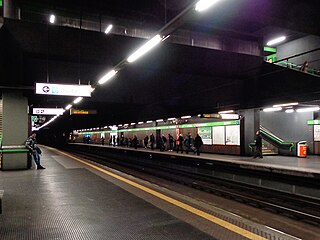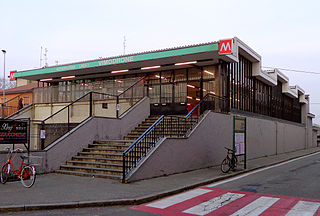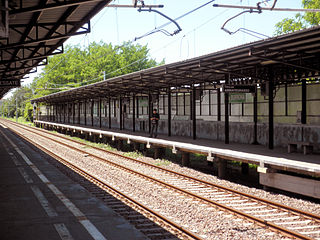
Milano Centrale is the main railway station of the city of Milan, Italy, and is the largest railway station in Europe by volume. The station is a terminus and located at the northern end of central Milan. It was officially inaugurated in 1931 to replace the old central station, which was a transit station but with a limited number of tracks and space, so could not handle the increased traffic caused by the opening of the Simplon Tunnel in 1906.

The Milan Metro is the rapid transit system serving Milan, Italy, operated by Azienda Trasporti Milanesi. The network consists of 5 lines, identified by different numbers and colours, with a total network length of 101.6 kilometres (63.1 mi), and a total of 119 stations, mostly underground. It has a daily ridership of about 1.4 million on weekdays.

Università Cattolica del Sacro Cuore, known as UCSC or UNICATT or simply Cattolica, is an Italian private research university founded in 1921. Cattolica, with its five affiliated campuses, is the largest private university in Europe and the largest Catholic University in the world. Its main campus is located in Milan, Italy, with satellite campuses in Brescia, Piacenza, Cremona and Rome.

Line 5 is an underground rapid transit line in Milan, Italy, part of the Milan Metro. The line, also known as M5 or the Lilac Line, is 12.8-kilometre (8.0 mi) long and goes through the city from the north to the north-west. It opened in stages between 2013 and 2015.
Milano Porta Garibaldi is a major railway station in the Italian city of Milan, located just to the north of the neighbourhood known as Porta Garibaldi. Porta Garibaldi is the city's main station for commuter traffic with 25 million passengers annually, although it is second to Centrale station considering total passenger traffic. The station is located on Piazza Sigmund Freud.

Sant'Ambrogio is an underground station on Line 2 of the Milan Metro. It was opened on 30 October 1983 as part of the extension of the line from Cadorna to Porta Genova. The station takes the name from nearby Basilica of Saint Ambrose.

Lanza is an underground station on Line 2 of the Milan Metro. The station was opened on 3 March 1978 as part of the extension from Garibaldi FS to Cadorna.

Garibaldi FS is a station on Lines 2 and 5 of the Milan Metro, and the Milan Passante railway. The Line 2 station was opened on 21 July 1971 as part of the extension from Centrale. It served as the western terminus until 3 March 1978, when the first trains could travel the new route to Cadorna. The Passante station was opened in 1997, and the Line 5 station in 2005.

Lodi railway station serves the city and comune of Lodi, in the region of Lombardy, northern Italy. Launched 1861, it lies along the Milan–Bologna railway.

Affori Centro is a station on Line 3 of the Milan Metro which opened on March 26, 2011, twenty-one years after the opening of the original trunk of the line. It is one of the four stations on Line 3 opened to the public in 2011, forming the section from Dergano to Comasina.

Cimiano is a station on Line 2 of the Milan Metro. The station is located near the junction between Via Palmanova, Viale Don Luigi Orione, Via Don Giovanni Calabria and Via Pusiano, in the district of Cimiano. The station was opened on 27 September 1969 as part of the inaugural section of Line 2, between Cascina Gobba and Caiazzo.

The Zone 6 of Milan is one of the 9 administrative zones of Milan, Italy. It corresponds to the south-western zone of the city.

Vimodrone is a suburban station on Line 2 of the Milan Metro in the municipality of Vimodrone.

Cascina Burrona is a suburban station on Line 2 of the Milan Metro in the village of Cascina Burrona, which is in the municipality of Vimodrone.

Cernusco sul Naviglio is a suburban station on Line 2 of the Milan Metro in the municipality of the same name.

Villa Fiorita is a suburban station on Line 2 of the Milan Metro in the village of Villa Fiorita, which is in the municipality of Cernusco sul Naviglio.

Cassina de' Pecchi is a suburban station on Line 2 of the Milan Metro in the municipality of the same name.

Bussero is a suburban station on Line 2 of the Milan Metro in the municipality of the same name.

Villa Pompea is a suburban station on Line 2 of the Milan Metro in the locality of Villa Pompea, a suburb of Gorgonzola near the northern Italian city of Milan.

Franca Helg was an Italian designer and architect. She also had a career teaching at Istituto Universitario Architettura Venezia and Polytechnic of Milan. She collaborated with Franco Albini from 1945 through 1977.



















